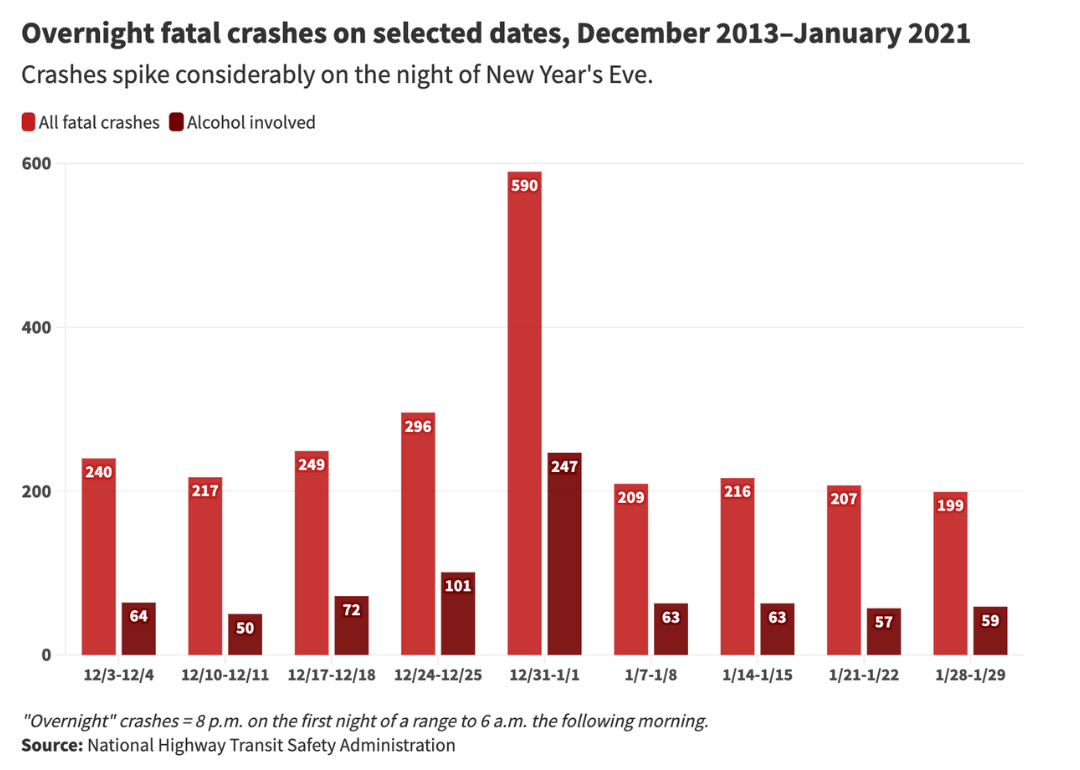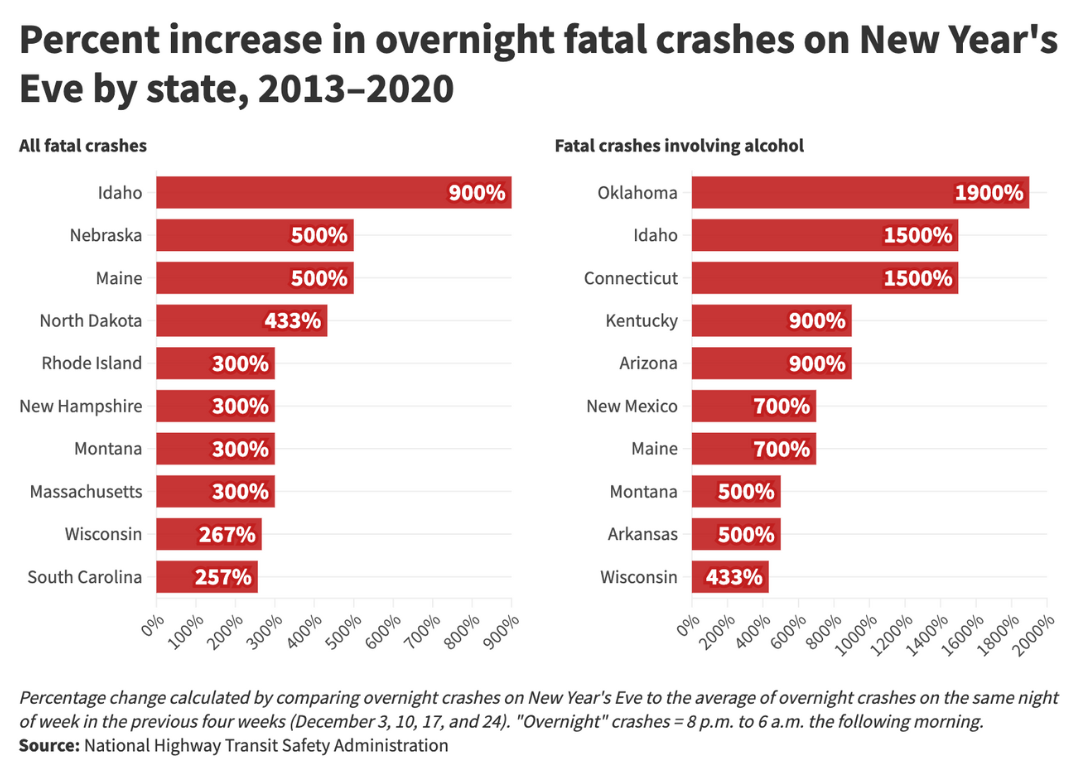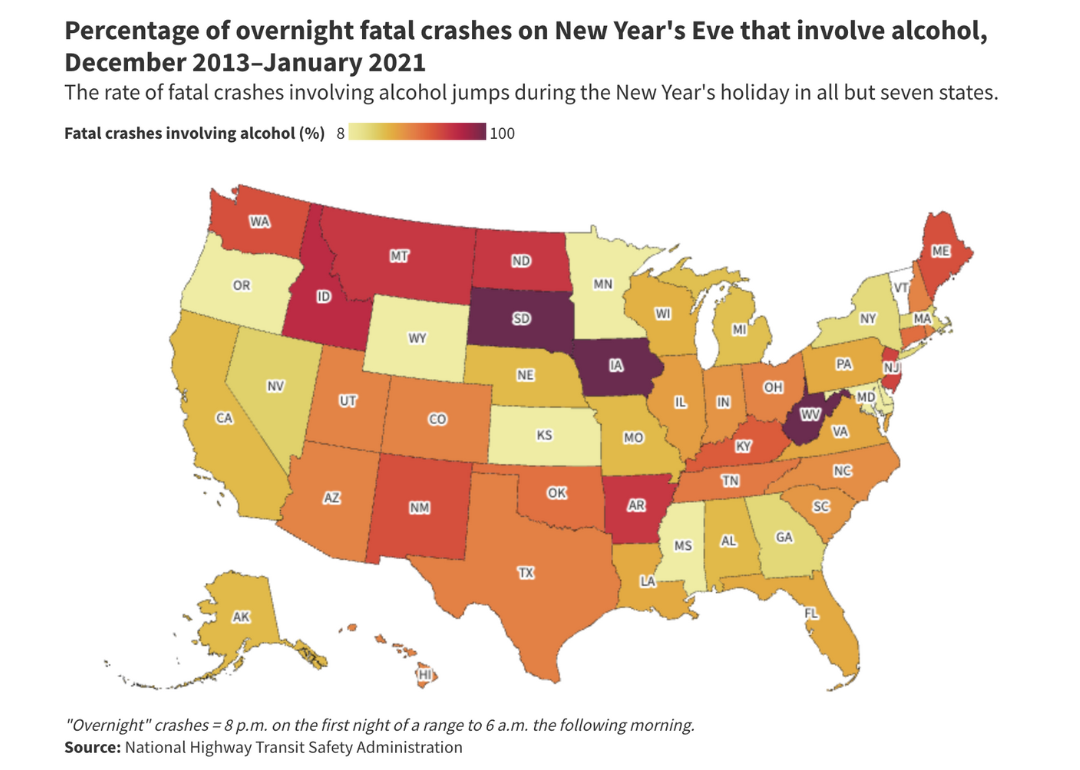How dangerous is driving on New Year's Eve?

Canva
How dangerous is driving on New Year’s Eve?
A group of people celebrating New Year’s
As November gives way to December, most of the emphasis has been on Christmas. But New Year’s Eve is now just around the corner, and it brings elevated risks with it.
A 2021 Yahoo! Finance article cites data from Womply showing that New Year’s Eve is the biggest sales day of the year for liquor stores across the U.S., with revenue jumping more than 159% over the average day. And any holiday with a heavy emphasis on alcohol consumption is likely to lead to a spike in deadly car crashes.
To quantify just how much more dangerous American roads are over the New Year’s holiday, Sargon Law Group analyzed records of more than 12,000 fatal car crashes from the National Highway Transit Safety Administration’s Fatality Analysis Reporting System database, comparing crashes on December 31 and January 1 to similar periods in the four weeks before (December 3-4, December 10-11, December 17-18, and December 24-25) and four weeks after (January 7-8, January 14-15, January 21-22, and January 28-29).
Key findings
- New Year’s Eve and New Year’s Day have 13% more fatal crashes than the same time frames in the previous four weeks, but the number of overnight fatal crashes spikes by 136%.
- More than 40% of New Year’s Eve overnight fatal crashes involve alcohol, three times the national average throughout the year. In 23 states, including Arizona, the rate is 50% or higher.
- Half of all states see an increase of 200% or more in alcohol-related fatal crashes overnight on New Year’s Eve compared to the previous four weeks.
![]()

National Highway Transit Safety Administration
There are more than twice as many crashes overnight on New Year’s Eve
A bar chart of Overnight fatal crashes on selected dates, December 2013–January 2021 – “Overnight” crashes = 8 p.m. on the first night of a range to 6 a.m. the following morning.
Across the eight-year window we looked at, fatal crashes on New Year’s Eve and New Year’s Day are 13% higher than the average of the four previous weeks and 28% higher than the average in the four following weeks.
On its own, that would be a noticeable jump. But when you isolate the overnight period, the results really jump out. The FARS data reveals an average of 251 overnight crashes during the four December periods and 208 during the January periods, compared to nearly 600 fatal crashes during the New Year’s Eve overnight period. That’s more than double (+136%) the December average — and almost triple (+184%) the January average.
The size of the increases fluctuated year by year across the eight holiday seasons we looked at, but there were big spikes in fatal overnight crashes every year:
- 2013/14: +291%
- 2014/15: +217%
- 2015/16: +88%
- 2016/17: +61%
- 2017/18: +124%
- 2018/19: +152%
- 2019/20: +94%
- 2020/21: +168%
Even accounting for a relatively small sample size, the pattern is clear: New Year’s Eve is a significantly more dangerous night to be on the road.

National Highway Transit Safety Administration
Fatal crashes spike in nearly every state — especially when alcohol is involved
bar chart of Percent increase in overnight fatal crashes on New Year’s Eve by state, 2013–2020 – Percentage change calculated by comparing overnight crashes on New Year’s Eve to the average of overnight crashes on the same night of week in the previous four weeks (December 3, 10, 17, and 24). “Overnight” crashes = 8 p.m. to 6 a.m. the following morning.
There are only three states where the number of fatal crashes overnight on New Year’s Eve is lower than the December averages: Maryland, Kansas, and Vermont — the only state that had no fatal New Year’s Eve crashes in any of the eight years we looked at.
But in 34 states, New Year’s Eve overnight crashes go up by 100% or more (a list that doesn’t include Alaska or the District of Columbia, which reported overnight fatal crashes on New Year’s Eve but not on any of the December dates we analyzed). And they triple (a 200% or greater increase) in 14 states.
The biggest jumps in overnight fatal crashes from December averages to New Year’s Eve by state:
- #1 Idaho: +900%
- #2 (tie) Maine: +500%
- #2 (tie) Nebraska: +500%
- #4 North Dakota: +433%
- #5 (tie) Massachusetts: +300%
- #5 (tie) Montana: +300%
- #5 (tie) New Hampshire: +300%
- #5 (tie) Rhode Island: +300%
- #9 Wisconsin: +267%
- #10 South Carolina: +257%
The effect is even more pronounced when looking at crashes involving alcohol, where the number of crashes goes up by 244% compared to the December averages. Fatal crash volume involving alcohol triples in 26 states (not including the seven that reported alcohol-involved overnight fatalities on New Year’s Eve but not on the December dates).
The biggest spikes in overnight fatalities involving alcohol:
- #1 Oklahoma: +1900%
- #2 (tie) Connecticut: +1500%
- #2 (tie) Idaho: +1500%
- #4 (tie) Arizona: +900%
- #4 (tie) Kentucky: +900%
- #6 (tie) Maine: +700%
- #6 (tie) New Mexico: +700%
- #8 (tie) Arkansas: +500%
- #8 (tie) Montana: +500%
- #10 Wisconsin: +433%

National Highway Transit Safety Administration
Fatal crashes are three times as likely to involve alcohol overnight on New Year’s Eve as they are the rest of the year
A map of Percentage of overnight fatal crashes on New Year’s Eve that involve alcohol, December 2013–January 2021 – “Overnight” crashes = 8 p.m. on the first night of a range to 6 a.m. the following morning.
FARS data shows that about 14% of all fatal crashes throughout the year involve at least one driver who is under the influence of alcohol. During the overnight period on New Year’s Eve, that rate spikes all the way to 42% — a 208% increase.
In fact, except for the seven states that reported no alcohol-involved fatal crashes on New Year’s Eve (Delaware, Kansas, Maryland, Minnesota, Oregon, Vermont, and Wyoming), the percentage of fatal crashes that involve alcohol goes up during the New Year’s Eve overnight period in every state.
More than 50% of overnight fatal crashes on New Year’s Eve involve alcohol in 16 states, spread across the entire country: Arkansas, Connecticut, Idaho, Iowa, Kentucky, Maine, Montana, New Jersey, New Mexico, North Dakota, Oklahoma, South Dakota, Tennessee, Texas, Washington, and West Virginia.
As a comparison, only five states have rates of fatal crashes involving alcohol that top 20% during the rest of the year: Montana (the highest at 31.7%), North Dakota, South Dakota, Vermont, and Wyoming.
What can you do to stay safe over New Year’s Eve?
If you have to get to and from your New Year’s party, the most obvious answer is to avoid drinking and driving, or riding with a driver you know has been drinking, under any circumstances. You may not be able to control the other drivers on the road, but if you get behind the wheel while under the influence, you put yourself — and everyone in the car with you — in danger.
Additionally, wearing your seatbelt can’t prevent a crash from happening, but it’s been proven to prevent unnecessary deaths and serious injuries.
Data sources and methodology
Crash data comes from the Fatality Analysis Reporting System, a database of fatal motor vehicle crashes maintained by the National Highway Transit Safety Administration.
We used data from December 2013 to January 2021. To control for seasonal trends in crashes and variance by day of week, we focused on the four weeks before New Year’s Eve and the four weeks after, looking at the same days of the week.
“December crashes” refer to crashes occurring 12/3-12/4, 12/10-12/11, 12/17-12/18, or 12/24-12/25. “January crashes” refers to crashes that took place 1/7-1-8, 1/14-1/15, 1/21-1/22, or 1/28-1/29.
Some analyses are based on the full-day data, while others look at “overnight” crashes, which we defined as anywhere from 8 p.m. on New Year’s Eve (or the first day of one of the other periods) to 6 a.m. on New Year’s Day (or the second day).
This story was produced by Sargon Law Group and reviewed and distributed by Stacker Media.





